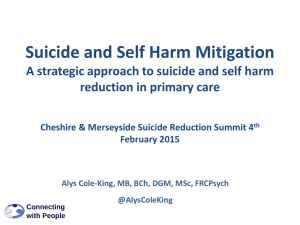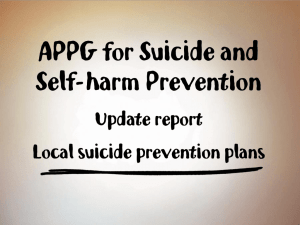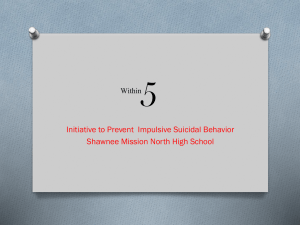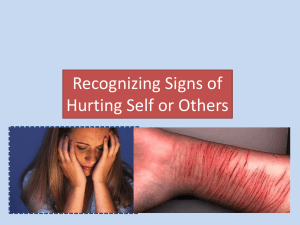Teenage Suicide
advertisement
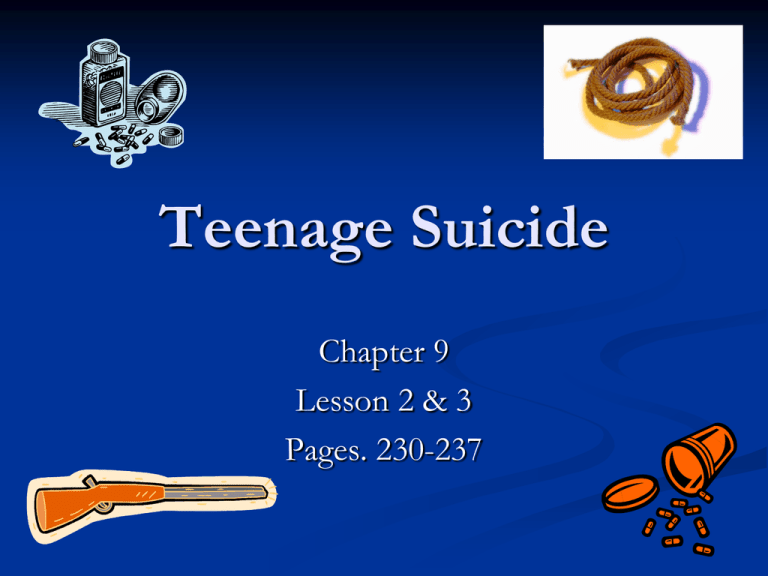
Teenage Suicide Chapter 9 Lesson 2 & 3 Pages. 230-237 Suicide Prevention and Getting Help Objective 1: List the warning signs of suicide Objective 2: Determine strategies to prevent suicides and strategies for coping with depression. Objective 3: Tell early detection and warning signs that prompt individuals of all ages to seek mental health care. Objective 4: Describe methods for addressing critical mental health issues. Objective 5: Select available mental health services in the community. Facts & Myths on Suicide 1. 2. 3. 4. 5. 6. 7. 8. 9. People who talk about suicide don’t commit suicide Suicide happens without warning Suicidal people are fully intent on dying Once a person is suicidal, they are suicidal forever Improvement following a suicidal crisis means that a suicide risk is over Every person who commits suicide is mentally ill. Suicide is more common among the lower socioeconomic groups Suicide is caused by one very traumatic loss in the victims life. There is nothing you can do to stop a suicide. Teenage Suicide Suicide: The intended taking of one’s own life. The rate of reported suicides among young people has nearly tripled in the last 30 years and continues to increase More than 90% of the people who kill themselves are suffering from depression or another mental disorder or are abusing alcohol/drugs (pg.230). MSNBC Video (Teenage Suicide) http://www.msnbc.msn.com/id/21134540/vp/265 14390#26514390 Causes of teen suicide (yellow text book 117) Deep Gloom Loneliness Hopelessness of Depression Young people may attempt suicide because they think that life’s bad feelings will last forever. Having an unrealistic, romantic view of death Feeling like a failure Inability to express anger or pain Other reasons teens may attempt suicide (Yellow textbook 117) Lacking firm values or rules on which to base life decisions Suffering a loss and seeing no end to deep grief Having a relative or friend commit suicide Trying to impress another person with the urgency of their feelings. video, “Myspace Suicide” http://www.cbsnews.com/video/watch/?id=46 24609n&tag=mncol;lst;4 The vast majority of those who attempt suicide do not want to die; they are suffering and are making a plea for help! Did you know? Four males commit suicide to every 1 female, and represent 79.4% of all U.S suicides. Females attempt suicide 2-3 times as often as males do Firearms are the most commonly used method of suicide among males (57.6%) Poisoning is the most common method of suicide for females (39.1%) http://www.cdc.gov/ViolencePrevention/pdf/Suicide-DataSheet-a.pdf Recognizing the verbal warning signs (pg. 231) Direct statements (I want to die, I don’t want to live anymore, I wish I were dead) Indirect statements (I won’t have to put up with this much longer, they’ll be sorry when I’m gone, soon the pain will be over) Writing poems, songs, or diary entries that deal with death Suicide threats or insinuations Recognizing the nonverbal or behavioral signs (pg. 231) An unusual obsession with death Withdrawal from friends Giving away personal belongings Deterioration in schoolwork or recreational activities. Dramatic changes in personality, hygiene, or appearance. Substance abuse Use C.L.U.E.S. to remember how to help someone suffering emotionally (pg. 232) Connect (make contact) Listen (active listening skills) Understand (empathize with their feelings) Express concern (say that you care and stay with the person) Seek help (encourage the person to talk to an adult and you tell an adult yourself) Getting Help pg. 234 Knowing when to get help! You feel trapped or you worry all the time Your feelings affect your sleep, eating habits or school work Your friends and family express concern You are becoming involved with alcohol and drugs You are becoming increasingly aggressive, violent or reckless Activity What would you do in these Scenario's? Scenario #1: You are on the phone talking to your friend and he/she tells you that they are having another horrible day and that they are going to commit suicide. Scenario #2: You and your friend are in the hallway and he/she tells you again that they feel no love from his her parents and that he/she hopes that they miss me when I’m gone. Worksheets Pass out worksheet, “Warning Signs” Pass out worksheet, “Active Listening” Interactive Study Guide http://glencoe.mcgrawhill.com/sites/dl/free/0078726549/359992/Int erActCh9Ls2.html Online Quiz http://glencoe.mcgrawhill.com/sites/0078726549/student_view0/chap ter9/online_quizzes.html



